Inclusive

Comms

Guide
Your guide to inclusive and equitable workplace communications
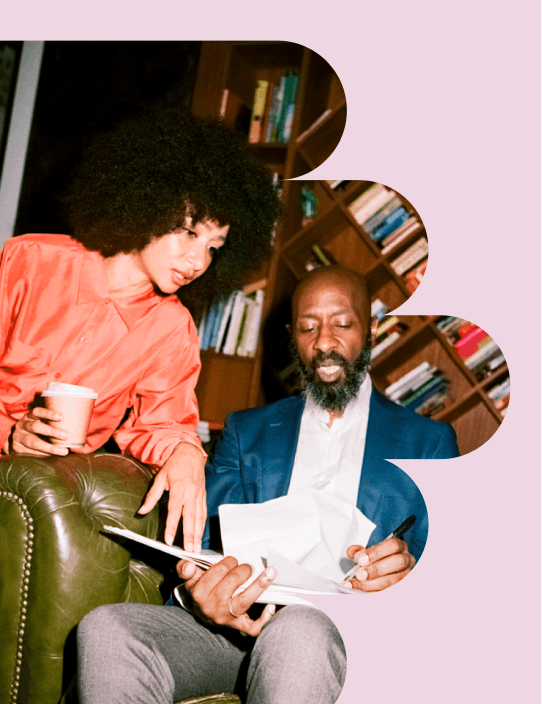
Introduction
Creating an inclusive culture is not a one-and-done process.
Listen to this chapter of Inclusive Communications (5.5 mins)
Over the last decade and in response to growing pressure from employees more companies recognized the importance of building diverse, equitable and inclusive workforces and workplaces.
These organizations spent billions on launching new initiatives. In fact, the global market for Diversity and Inclusion was projected to be US$15.4 Billion by 2026. They hired staff dedicated to DEI, and offered DEI-related training sessions with the expectation that through these actions they could create a more inclusive and equitable workplace culture.
Then throughout 2022 and 2023 came the budget cuts and layoffs that disproportionately impacted DEI positions and DEI initiatives, making it that much harder to meet those expectations.
Inclusion and belonging cannot be achieved through one-off initiatives and training. Nor can inclusion and belonging goals be realized by a lone DEI champion. Building an inclusive and equitable culture requires an embedded, systemic strategy. A fundamental component of which is how organizations communicate with their employees.
Before we explore how to create inclusive workplace communication, we first need to create a shared understanding of core concepts we’ll be using in this guide. Below we define inclusion, along with its siblings diversity, equity, and belonging. Each term includes further detail at the link.
Inclusion
Inclusion is a workplace culture that is welcoming to all people regardless of race, ethnicity, sex, sexual orientation, nationality, immigration status, gender identity, age, abilities, and religion, where different perspectives are respected and valued. Source
Diversity
Diversity is the presence of differences that enrich our workplace. Some examples of diversity may include race, gender, religion, sexual orientation, ethnicity, nationality, socioeconomic status, language, (dis) ability, age, religious commitment, or political perspective in our workplace.
Source
Equity
Equity is promoting justice and fairness within the procedures, processes, and distribution of access, opportunities, and resources by institutions or systems. Tackling equity issues requires an understanding of the root causes of outcome disparities within our society. Source
Belonging
Belonging is an outcome of inclusion. It is when people feel accepted, welcomed, and included.
Inclusive Language
Inclusive language is language that is free from words, phrases or tones that reflect prejudiced, stereotyped or discriminatory views of particular people or groups. It is also a language that does not deliberately or inadvertently exclude people from feeling accepted. The use of inclusive language plays an important role in promoting higher employee engagement, superior customer service and increased productivity—all important aspects of a positive work culture. Source
Inclusive Communication
Inclusive communication is using inclusive language to share information and ideas in a way that is respectful, considerate of and caring for the audience.
How companies communicate and the language they use is a foundational tool in creating inclusion, equity, and belonging within their organization. It is how they demonstrate at a fundamental level they recognize their employees’ individuality and humanity.
Employees, especially those who are members of marginalized groups, are acutely aware of the difference between what a company says and what a company does. They understand the difference in the communication they receive from the company year-round and the communication that happens periodically around the launch of a DEI initiative or training. They observe how a policy is worded, whose needs are accommodated, and if external communications match internal ones.
Communicating inclusively isn’t about abiding by a list of terms and ticking off the boxes of the right thing to say. Language evolves. Culture evolves. Therefore, how we communicate and the language we use will also evolve.
The purpose of this guide, last updated in July 2023, is to help you develop foundational inclusive communication skills through a framework for inclusive communications that is based on understanding your audience and the importance of language.
We’ll also cover how to address pushback to implementing inclusive language at your company, how to implement what you’ve learned in this guide, and further resources to support you.
Remember, building an inclusive and equitable culture requires an embedded, systemic strategy. A fundamental component of this strategy must be how organizations communicate with their employees - this guide is the first step.

Stacey Nordwall
Stacey Nordwall is the Head of Employee Experience at Pyn. She has an MA with Honors in Counseling Psychology from St. Mary’s College of California and a BA in Psychology and Communication from Stanford University. She is passionate about creating inclusive workplaces where people can thrive and helping People teams evolve to meet the new world of work.

Dr. A. Breeze Harper
Dr. Harper is a senior-level diversity and inclusion research analyst, consultant, trainer, and Co-Founder of Critical Diversity Solutions with a PhD in Cultural Geography. She is recognized as an expert and vanguard around issues of diversity in the fields of education, food, and health. She received her MA from Harvard and her BA at Dartmouth.

Why Creating An Inclusive Culture Matters
Get stats on why it matters and write down your "why"
Listen to this chapter of Inclusive Communications (5 mins)
Employees are becoming more empowered to demand that workplaces meet their expectations. The Great Resignation is a phrase on everyone’s mind, as is the implication that people are quitting jobs that don’t align with their personal values.
From the Great Resignation to Quiet Quitting to layoffs, employees have been through a lot in the past few years. It seems the result of this experience is that employees' expectations and what they seek in a workplace expanded to include factors such as values alignment, a sense of purpose, and culture.
In no small part because of the experience of the pandemic, employees have increasingly been examining the role of work in their lives. As part of this evaluation, employees’ expectations about the organizations they work for have changed. Employees expect the organization they work for to foster inclusive environments and positively impact society.
From an organizational perspective, there are numerous examples of the positive impact of building an inclusive culture:
- Less employee turnover and a more engaged workforce (Catalyst)
- Increased innovation and performance (Catalyst)
- Increased profitability (35%) and value creation (33%) with the presence of racially diverse executive teams versus non racially diverse teams (McKinsey)
- Increased profitability (21%) and value creation (27%) with the presence of gender-diverse executive teams versus non gender-diverse executive teams (McKinsey)
- Ability to meet the customer demand for representation and accessibility of products and services (Forbes and Forbes)
Why is this particularly important now?
We’re more interconnected now than ever before and we’re facing challenges - pandemic, climate change, political instability - that are global in nature. At the same time, the increase in remote, distributed workforces means that organizations must be equipped to meet the needs of and challenges faced by a diverse workforce.
Employees want the organizations they work for to be committed to DEI both internally and externally. In part, this is a result of a sociopolitical climate in which employees have witnessed:
- The increase of violence against the Black, LGBQTIA+, and Asian communities within the USA (NBC News and Human Rights Campaign)
- The global adverse and unequal impact the pandemic has had on women in the workforce (McKinsey)
- The global adverse and unequal impact the pandemic has had on employees identifying as women, people of color, or LGBQTIA+ (McKinsey)
As Dr. Harper explains:
“DEI cannot be an afterthought, it must be part of an organization's mission, values, and systems. Before working with Critical Diversity Solutions, consequences of some of our clients' inability to implement DEI ranged from racial discrimination lawsuits, to less innovative product designs, to high attrition rates for managers, to losing customers because their marketing language was exclusive."
The “Great Resignation” of 2021-2022 in the USA was in many ways a response to people seeking organizations that were more inclusive and equitable towards their employees.
Why using inclusive language matters
Using language precisely and intentionally demonstrates respect and care for the recipient because it focuses on the impact on the recipient. It is a recognition of that person’s individuality and humanity. It creates a sense of belonging and connection because it feels personal. Using inclusive language is also a signal to the recipient that your organization seeks to create an inclusive, safe and equitable environment.
Building an inclusive and equitable culture is an ongoing process and commitment - one that will not proceed in a direct line and one where you will make mistakes
When it comes down to it, the most important Why is why it matters to you and your company. Building an inclusive and equitable culture is an ongoing process and commitment - one that will not proceed in a direct line and one where you will make mistakes. However, this is the normal process of transformation because inclusion and equity practices are a continuum. Knowing your why will help you move through your mistakes and continue your practice.
Find your “why.” Take a minute to answer these three questions:

The Inclusive Communication Framework
Explore the inclusive communication framework
Listen to this chapter of Inclusive Communications (18 mins)
Now that we've reviewed why building an inclusive culture matters, it's time to explore the inclusive communication framework that you can implement in your workplace.
Communicating inclusively goes beyond choosing specific words. It involves changing how we communicate from being a largely unconscious process (influenced by our own biases) into a conscious, intentional process. This is the purpose of the framework.
Let’s start with an example message you can refer to as you get familiarized with the framework. The most common, frequent and impactful communications sent to employees are onboarding messages, so we’ll use a brief welcome message as our example.
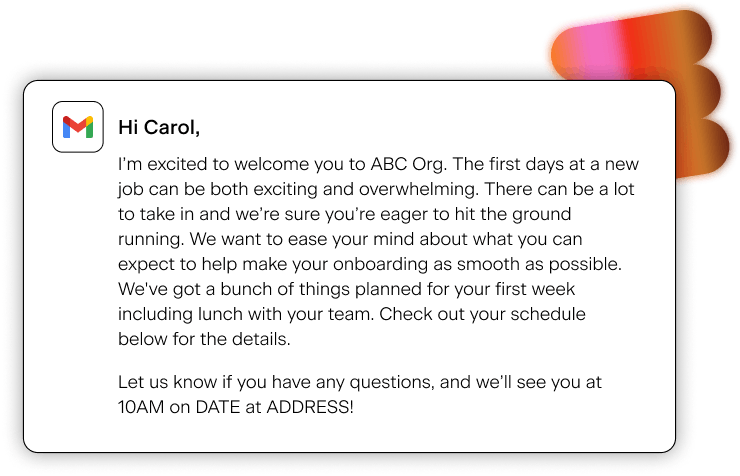
When framing a communication to be inclusive, think through these questions:
- Who is the audience for your communication and what are their needs?
- What is the best format for your communication?
- What should the tone of this communication be?
- What is the outcome I want from this communication?
- What assumptions might I be making in developing this communication?
Let’s examine the example onboarding message above with these questions in mind.
Audience
Who is the audience, what are their needs?
It could be: the organization as a whole, new hires, managers, senior leaders, ERG leadership, etc.
What are the possible demographics of this audience?
Have you addressed their needs in your communication?
In our example message, our audience is a new hire - Carol.
We don’t know Carol’s gender identity, so we have personalized the message to Carol by using their first name without titles such as Mr. or Ms. Carol’s need is to feel welcomed and have logistical information about their first day.
Format
What is the best format for this communication?
Is your communication accessible to neurodiverse and disabled individuals?
- The format you select will be influenced by the tone and desired outcome of the communication, as well as considerations like the type of information you are conveying and how discoverable it needs to be.
- For example, your communication may take the form of email, direct message in a messaging app, presentation at a company-wide meeting, company policy or program, page on an internal wiki, or event invitation.
Early onboarding messages are commonly sent by email or text.
In the case of an onboarding message, something which is crucial for new hires to receive, the message is best sent in a format that is easily accessible by the recipient.
Tone
What should the tone of this communication be?
The level of formality in the tone should be appropriate to the company culture, the nature of the message, and the communication’s format.
In this sample onboarding message, we use a friendly, relatively informal tone to help Carol feel welcomed to the organization.
Outcomes
What is the outcome I want from this communication?
Before sending a communication it’s important to understand the purpose of the message and any outcome you need.
For example, is your communication for informational purposes only? Or, do you need the audience to act on or comply with your communication?
The purpose of the message is to:
Welcome them to the organization
The outcome we want is:
They confirm their start date and time and arrive on the correct day and time
They feel prepared for their first day
Assumptions
What assumptions might I be making …
Regarding the audience’s demographics (e.g., gender, caregiver status, marital status, disability status, age, race, military status, religion)?
Regarding accessibility?
Regarding safety?
Regarding readability/understandability?
Regarding affordability?
Demographics: We don’t know Carol’s demographics, so we have not presumed a gender or used a title such as Mr. or Ms.
Accessibility: We have made an assumption that Carol has readily available internet or mobile access to read our message. We have also assumed that the building is physically accessible for Carol and accessible by whatever mode of transportation Carol uses.
Safety: We have assumed that the location of the office is safe for Carol.
Readability/understandability: We have assumed Carol knows the work euphemisms “hit the ground running” and onboarding.
Affordability: We have not made it clear if Carol will be expected to contribute to paying for lunch and may have assumed their ability to do so.
After thinking through these questions, you may determine some parts of the original communication don't need to be changed. For example, the format and outcome of the message are appropriate. There may also be parts of the communication you’d like to change and more detail you’d like to add to make the message more clear and address some possible assumptions.
So, let’s revisit our welcome message to Carol and make a few changes:
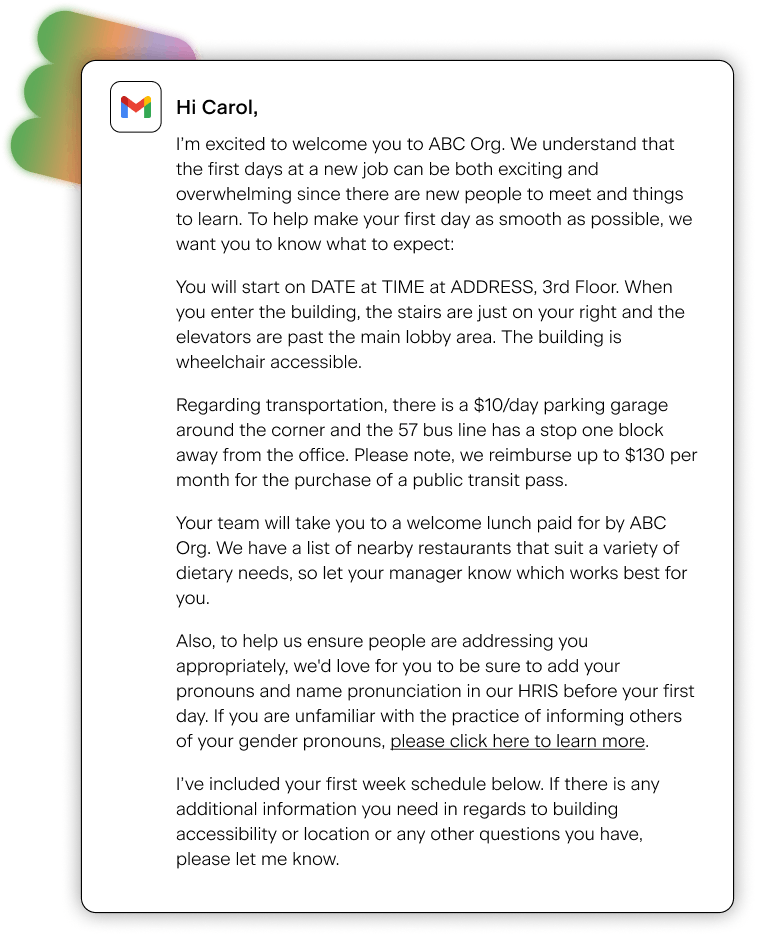
This example demonstrates that inclusive communication goes far beyond the words you choose. Thinking about the audience, format, tone, outcome and assumptions, results in an updated communication that is more thoughtful, welcoming, and considerate of the new hire thereby creating a more impactful and inclusive communication. We've outlined where and how to get started in the implementation section below.
Perhaps, though, you’re wondering if some of the information in this message is particularly relevant for Carol - and if not, why include it?
Time to explore our audience more in-depth.
Consider your audience
Generally, writers start crafting their communication by writing with a (likely subconscious) default audience in mind. This default audience is usually men who are white, financially-secure, able-bodied, heterosexual, Christian, and cis-gender, particularly if these are identities the writer shares. Then they think - oh, what about our transgender employees? Our Muslim employees? Our employees with disabilities? And so on.

Person-First or Identity-First Language - which should you use?
Person-first language is as it sounds - using language that puts the person first. This means using phrases like “employees with disabilities,” “a woman with autism,” or “a person with schizophrenia.”
Person-first language was developed with the intention of respecting and recognizing the person, as opposed to labeling them by their disability or health condition.
However, some individuals and communities prefer to use identity-first language, such as “disabled employees,” “an autistic woman,” or “a Deaf person.” They prefer this language because it is part of their identity and believe that the implication of using person-first language is that there is something stigmatizing or negative about acknowledging a person’s disability or health condition.
Deciding which language to use isn’t straightforward. The preference for person-first language or identity-first language can vary by community and by individual. We do not have a default recommendation for which to choose, and recommend that you consult the resources we have provided and your employees to decide which is appropriate for your organization.
We believe the pushback around creating inclusive communications stems from writing with this approach. A common criticism against inclusive communications is that they are too burdensome because there are so many identities to think about. Underlying this criticism is the biased mindset that some groups are considered to be “the norm” that communications should accommodate, and some groups are considered to be “other.”
You will not create an inclusive culture if this is your approach.
But what if you started with an alternate mindset and changed your communication strategy? What if you began your process with a different audience in mind?
Instead, what if you created a default reader profile and started crafting all of your communications with this profile in mind? For example, perhaps the default employee reader profile you create is a Muslim gender non-conforming woman of color in her 60s who uses they/them pronouns. Perhaps they are disabled and a caregiver to an elderly parent. Perhaps they recently immigrated to the country.
Imagine how this shift in strategy might change your communications, policies, and programs.
Starting with this default reader profile in mind, the likelihood is that the communications you craft will include more and different information, use different language, and particularly in the case of developing policies and programs - be supportive of more of your employees’ needs.
By crafting your communication so that it centers marginalized communities first, you will by default have created a communication that is inclusive of everyone
And, the bonus is that by crafting your communication so that it centers marginalized communities first, you will by default have created a communication that is inclusive of everyone, including those who have social identities that are part of the status quo (i.e., in the USA the status quo identities are white, financially-secure, able-bodied, heterosexual, Christian, cis-gender, man).
Creating an employee reader profile doesn’t mean your communication must list out all of the demographics used to craft your message. It’s simply a strategy to help you design your communication so that it is more inclusive from the outset.
Remember, the purpose of inclusive and equitable communication practices is to give ourselves the opportunity to test our assumptions, be accountable when or if we unintentionally exclude someone, and continue to grow our own DEI critical competency skills while learning from our mistakes along the way. This is not about achieving perfection or reaching an endpoint. This is an ongoing journey in which you will continue to evolve.
Consider your language
Now that you have become familiar with the inclusive communications framework and thought about developing your new default reader profile, it’s time to explore the words you choose.
There are a number of resources readily available on terms to use and terms to avoid (please refer to our resources list), so what we will cover are some general guidelines.
Use plain, easy to understand language
Plain language makes your writing clearer and easier to read for a broader audience. Using plain language makes your communications accessible to readers of a variety of literacy levels, to neurodiverse individuals, and to readers with first languages different to the language you write in.
Avoid Idioms and Jargon
Idioms and jargon are usually specific to a location, group, profession, culture, or socio-economic class and therefore can be inaccessible, difficult to understand, or unknown to those who didn’t grow up in the same area or with similar culture. They can also originate from stereotypes or come from historically racist, prejudiced, misogynist, or ableist practices.
For example: say having a quick meeting instead of “having a powwow,” say acting transparently instead of “open the kimono,” say preapproved or legacy instead of “grandfathered in,” or say people not having the necessary knowledge instead of “the blind leading the blind.”
Beware of euphemisms
A euphemism is “the substitution of an agreeable or inoffensive expression for one that may offend or suggest something unpleasant.” Unfortunately, euphemisms can be patronizing, condescending, harmful, and imply a “lesser than” status because they prioritize the comfort of the speaker and what the speaker thinks might be offensive or unpleasant over the respect and consideration for the audience.
For example: special needs, differently-abled, handicapable
Define your acronyms
For accessibility purposes and to ensure understanding of your communication, it is good practice to always define your acronyms.
Avoid terms that stigmatize
Stigmatizing terms label people in a derogatory manner based on physical or mental ability, mental health or addiction, or use medical terminology to refer to someone negatively or flippantly. These terms perpetuate negative views and attitudes about those groups.
For example: crazy, psycho, lame, insane, OCD, bipolar, addict, ADHD
Use preferred language and terms
Language is regional, personal, and evolving. For example, depending on a reader’s location, background, and preference, they may prefer to be referred to as Black or African-American; American Indian, Native American or Indigenous; an autistic man or a man with autism, and the preference they have now may be different than the preference they had 10 or 20 years ago. The preference they have may also be different than the preference of another reader with that identity.
So, what do you do? When you’re not sure which terms to use, it’s best practice to use the terms that are preferred by members of that community who hold that identity or to ask folks for their preferred term. However, this doesn’t mean it’s the job of marginalized people to tell you what terms to use. You should leverage the internal resources you have (perhaps ERG leadership would be willing to advise you) and do your research. We have included a variety of resources you can consult.
If someone gives negative feedback about a term, simply say thank you for sharing their feedback and ask them if they are willing to share the term they prefer; do not become defensive, as the purpose of DEI work is humility and accountability, not shame and blame.
Keep in mind that there are terms members of a community have reclaimed or used within their community that are not meant to be used by those outside of that community. You cannot use reclaimed words, like “n*gga” or “f*ggot,” if that is not one of your identities, and nevertheless, they should never be used in workplace communications.
Consider your format
The format you choose will depend on the information you want to convey and the accessibility needs of your audience. For example, if you are launching a new program, you may want to communicate about it using multiple methods, such as at a company-wide meeting and on your internal wiki. If your audience includes individuals who are neurodiverse, Blind or low-vision, or Deaf or hard of hearing, you may want to ensure the meeting includes captions or sign language translators, and that you follow up the meeting with a video recording and transcript, as well as an electronic copy of the program’s information in an accessible format.
Providing your communication in multiple formats helps to ensure that it will be accessible to people with a variety of accessibility needs.
When crafting your communication, we recommend these best practices:
- Use styles such as headings, subheadings, bullets and other formatting to make your documents easier to read and navigate for neurodiverse individuals and those using screen readers.
- Provide image descriptions or alt text for images, graphs, etc
- Use clear, descriptive text for links instead of the link itself or text like “read more”
- Choose easy to read fonts and colors
- Include captions, transcripts and/or audio descriptions for your video content
- Use your current tools’ embedded accessibility features to check your documents’ accessibility
For information shared via virtual or in-person meetings, we recommend these best practices:
- Provide materials prior to the meeting (i.e., agenda, PowerPoint deck, etc)
- Share the format of the meeting in advance along with instructions on how to participate (e.g., Will there be time to ask questions? Should people raise virtual hands to ask questions or ask in chat?)
- Enable captioning for virtual meetings
- Repeat questions asked prior to answering
- Request speakers say their name prior to speaking
- Provide a meeting recording and transcript after the meeting
Take a break to reflect and breathe…
Some of this information may be new to you. You may never have thought about words or phrases in this way before - that’s ok!
Languages are incredibly complex and have a rich history. We don’t expect you to know it all. In fact, as Dr. Harper reminds us, “No one person can or does know everything. That is the beauty of being a human being: our capacity to constantly learn new things and challenge ourselves in a way that helps make the world a better place." Developing your awareness about the words and phrases you choose and their origins will happen over time. We have included a number of resources including word lists that will help you.
“No one person can or does know everything. That is the beauty of being a human being: our capacity to constantly learn new things and challenge ourselves in a way that helps make the world a better place."

Implementing What You've Learned
You've learned a lot, see how you can put it into practice.
Listen to this chapter of Inclusive Communications (5 mins)
When implementing what you’ve learned for the first time, we recommend that you:
Remember your why
Go back to the questions in Why using inclusive language matters and revisit why it’s important to you to do this work. This will help you stay grounded and remind you of the impact you want to have with this work.
Create a default reader profile
In developing your default employee reader profile consider the following variables: gender identity, race/ethnicity, age, caregiver status, veteran status, immigrant status, religion, educational background, socioeconomic status, sexual orientation, physical or mental ability, and first/primary language.
Pick one communication you send regularly
For your first time using the inclusive communications framework, start with a message you’ve already written and that you send regularly. Choose an onboarding message, company update, or message to your team - something that is likely to have a high impact.
Use your default reader profile to apply the inclusive communication framework
With your default reader in mind, review your communication using the inclusive communication framework template in The inclusive communication framework section.
Revise your communication
As you reassess your communication with a new framework, find where you can provide more clarity and detail, choose different words, and update your message to be more inclusive
Celebrate
If you noticed or learned something in revising your communication or made changes that made your communication more inclusive, take a moment to celebrate and recognize the meaningful impact this first step can have.
Then… do it again!
It can be tempting to go into all the communications you’ve sent or policies and programs you’ve created and apply the framework now. However, we suggest that you take it one by one. As you start new communications or revisit and revise your policies and programs, follow the steps above. Each time you will iterate, discover something new, get more feedback, and continually improve your communications.
Embracing and learning from mistakes
This is a process of practice and iteration like any other learning process. Because you are changing behaviors you have learned over many years, it will also involve continuous unlearning, learning, and relearning. However, this change is achievable with the frameworks, resources, and every day habits we have discussed in this guide.
“This is a process of practice and iteration like any other learning process. Because you are changing behaviors you have learned over many years, it will also involve continuous unlearning, learning, and relearning."
Know that you will make mistakes, and that does not mean you have failed. This process will unearth some biases and the recognition of those biases provides an opportunity to grow, change, and become accountable.
There may be times when you negatively impact someone. While it will likely be unintentional, what matters is acknowledging and apologizing for that impact. When you apologize, you can ask if they are willing to share more about the impact it had on them without making it their burden to educate you. Then you learn and do better next time. It’s not a time to go on the defense, but an opportunity to learn and come closer to better understanding someone else. If you would like a framework for how to apologize with sincerity and accountability, we recommend this advice from Kim Scott.
It’s also important to understand that even if you implement every suggestion possible, your communication might exclude or offend someone. They may not understand the words you have chosen or why. They may have a different cultural or political lens or different experiences that lead them to prefer other terms. No group of people is monolithic, so even within a single demographic group or identity you may find some folks who felt included by your communication and some who did not. Their experiences are valid so there is no need to defend your communication by pointing out that another member of that group thought the communication was ok. Be open to their feedback, accept it, apologize and try to do better next time.
Remember - language evolves! So what works today, might need an update next year.
DEI work is an ongoing process, not a one-and-done initiative. In that spirit, this is the second version of our guide to inclusive and equitable workplace communications. If you have feedback, questions, or suggestions of resources to be added, please email us at hello@pynhq.com.
We are glad to be on this journey together. Thank you for reading!

Appendix
Get your copy of the Inclusive Communication Framework, FAQs, and additional resources
Listen to this chapter of Inclusive Communications (4 mins)
Our appendix includes a printable PDF version of the Inclusive Communication Framework, a "before and after" example of writing an inclusive job description, FAQs addressing pushback to implementing inclusive communication, and additional resources related to inclusive communication and language.
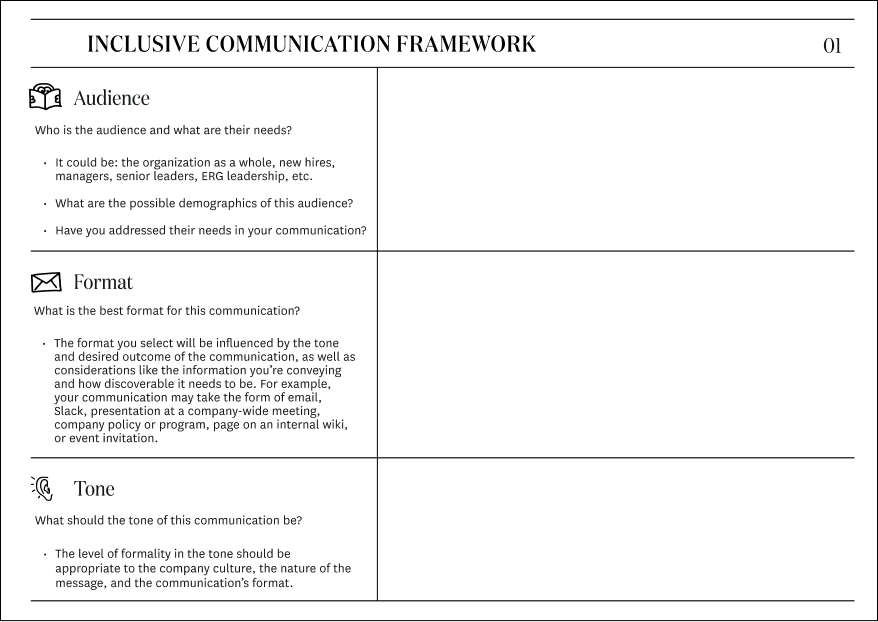
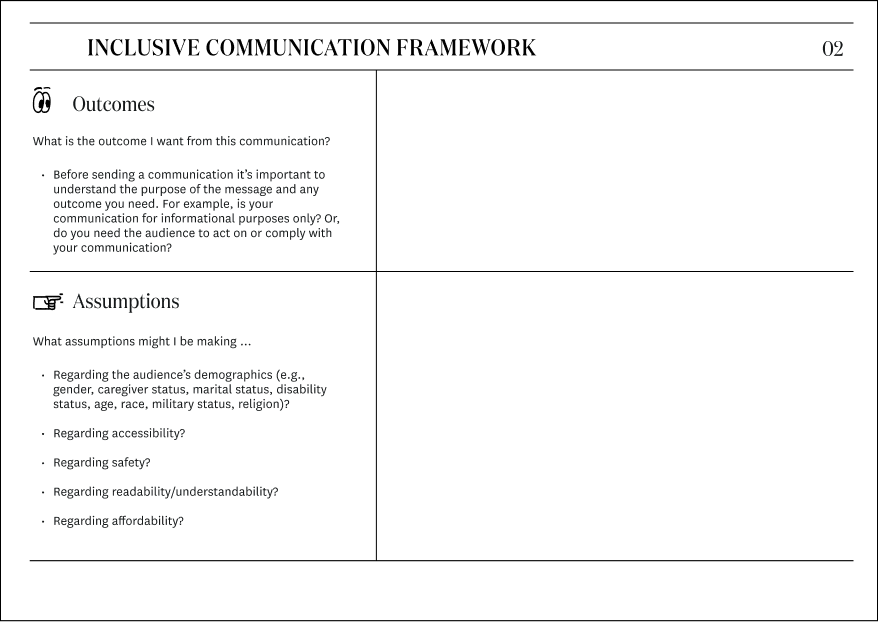
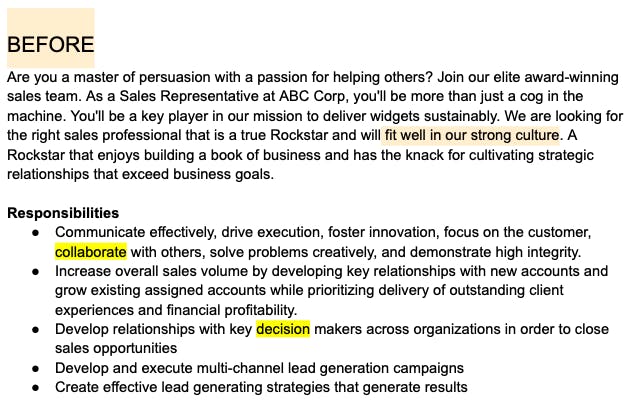
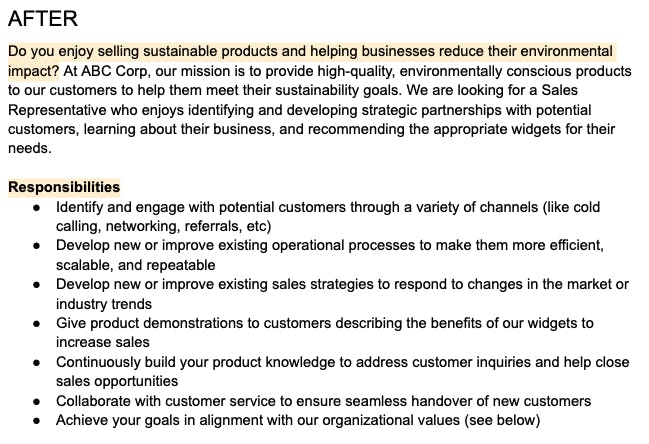
FAQ: Addressing pushback
It’s expected when implementing any new initiative to receive some pushback and for people to have questions about why the initiative is beneficial. Part of doing DEI work and of change management is allowing for open conversations to occur and addressing people’s concerns. We want you to feel prepared to respond, so here you will find common questions you might expect to get and how you may answer them.
Q: What if I “mess up” and don’t say the “right” thing? How will I recognize inclusive or exclusive language?
A: The thing is - you will not be perfect! But, that’s ok! No one is perfect in any area of life and we are not seeking perfection. We don’t want to shame or guilt anyone, and we understand that there might be new things to learn. We also recognize that many of us have spent years communicating and using language in one way, and that unlearning is a process that doesn’t happen overnight. Identifying inclusive or exclusive language is a skill that you will need to develop over time. That’s a journey we will be on together and we ask that you be willing to learn. When you “mess up,” treat it as any other time you have messed up - apologize, thank whoever brought it to your attention, and use it as an opportunity to do better next time.
Q: A few people seem to get offended and take things too seriously, so now we have to be politically correct?
A: Changing the way we communicate isn’t about politics, being PC, or being “woke.” It also isn’t an effort to shame, blame, or guilt anyone. When we focus on how we communicate and the language we use to communicate, we are prioritizing fairness and equity in service of creating a workplace environment that supports everyone’s ability to succeed and belong.
Q: If we do this, aren't we/our activities becoming too boring?
A: In moments of change, it’s common to focus on what we think we might lose instead of what we might gain. So let’s focus on what we might gain from implementing an initiative to build inclusion (Catalsyt):
- Increased trust and engagement
- Reduction of interpersonal aggression, discrimination and harassment
- Increased job satisfaction
- Increased innovation and creativity
Not to mention that by creating a more open, inclusive environment, we develop more opportunities to experience different ideas and perspectives.
Q: Don’t we want to bring people into the conversation and avoid making anyone feel bad?
A: Yes, we want people to participate in this journey with us and learn. That doesn’t mean that everyone will always feel comfortable because sometimes learning requires a bit of discomfort. It is important to understand that feeling uncomfortable and feeling unsafe are not the same thing. When you think about the workplace culture we are building, we have to think about who we are making this culture safe for. By implementing inclusive communication we prioritize creating a safe workplace environment not just for some, but for all. We also want to be clear that this isn’t about labeling people as “good” or “bad” - making mistakes doesn’t make someone a bad person.
Resources
The following section lists out additional resources in the following categories:
- DEI Consultancies
- Inclusive Style Guides + Tools
- Language to use when communicating to/about folks with disabilities or in reference to ableism
- LGBQTIA+ specific language
- Gendered nouns and gender identity
- Searchable compendiums on inclusive language
- General tips for inclusive writing and culture
- Company style guides focused on inclusivity
If you have a resource suggestion to be added to our list, please email hello@pynhq.com with "Inclusive Comms Resource" in the subject line.
Language to use when communicating to/about folks with disabilities or in reference to ableism

How Disabled People Struggle With Awkward Comments

Why You Need to Stop Using These Words and Phrases

Disability Language Style Guide

Glossary of Ableist Phrases
Violence in Language: Circling Back to Linguistic Ableism

How to avoid using ableist language

Person First and Identity First Language
LGBQTIA+ specific language
Gendered nouns and gender identity

How to Talk About Pronouns at Work: A Visual Guide

Talking about pronouns in the workplace

Gender-Inclusive Language

Glossary of Terms: Transgender

A Guide To Gender Identity Terms
Searchable compendiums on inclusive language
General tips for inclusive writing and culture

How to make your writing more inclusive

Building an Inclusive Culture Through Language | Dashlane DEIB Training

Gender inclusion: a guide

Guidelines for inclusive language

Write inclusive documentation

Inclusive writing for writers

Communication Theory: Racially Diverse and Inclusive Perspectives
Company Style Guides focused on inclusivity






